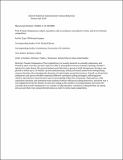Files in this item
Female chimpanzees adjust copulation calls according to reproductive status and level of female competition
Item metadata
| dc.contributor.author | Fallon, Brittany Laurie Ann | |
| dc.contributor.author | Neumann, C | |
| dc.contributor.author | Byrne, Richard William | |
| dc.contributor.author | Zuberbuhler, Klaus | |
| dc.date.accessioned | 2017-01-28T00:32:27Z | |
| dc.date.available | 2017-01-28T00:32:27Z | |
| dc.date.issued | 2016-03 | |
| dc.identifier | 240103502 | |
| dc.identifier | 236f4258-d1a3-403e-9e03-e09dc89121c3 | |
| dc.identifier | 84956731187 | |
| dc.identifier | 000371257300013 | |
| dc.identifier.citation | Fallon , B L A , Neumann , C , Byrne , R W & Zuberbuhler , K 2016 , ' Female chimpanzees adjust copulation calls according to reproductive status and level of female competition ' , Animal Behaviour , vol. 113 , pp. 87-92 . | en |
| dc.identifier.issn | 0003-3472 | |
| dc.identifier.other | ORCID: /0000-0001-9862-9373/work/60630588 | |
| dc.identifier.other | ORCID: /0000-0001-8378-088X/work/64360759 | |
| dc.identifier.uri | https://hdl.handle.net/10023/10190 | |
| dc.description | This project has received funding from the European Union's Seventh Framework Programme for research, technological development, and demonstration under grant agreement no. 283871. | en |
| dc.description.abstract | Female chimpanzees (Pan troglodytes) are usually depicted as sexually submissive and bound by male coercion, because males are able to monopolize oestrous females, limiting a female's options for mate choice. We present behavioural data from a group of wild chimpanzees during a rare period in which up to 10 females cycled simultaneously, which prevented males from monopolizing oestrous females, thus changing the dynamic of male-female sexual interactions. Overall, we found that nulliparous and parous females employed different copulation calling strategies, reflecting their relative reproductive attractiveness and social standing within the community. Male partner rank, copulation duration, and dominant male audience further influenced calling behaviour, and there was a non-significant trend for females to increase calling as the number of cycling females increased. We conclude that female chimpanzees are capable of adjusting their copulation calling flexibly, by taking into account their own sexual attractiveness in order to incite male competition. | |
| dc.format.extent | 1056947 | |
| dc.language.iso | eng | |
| dc.relation.ispartof | Animal Behaviour | en |
| dc.subject | Chimpanzee | en |
| dc.subject | Parity | en |
| dc.subject | Female competition | en |
| dc.subject | Copulation call | en |
| dc.subject | Sexual signal | en |
| dc.subject | RC0321 Neuroscience. Biological psychiatry. Neuropsychiatry | en |
| dc.subject | QH301 Biology | en |
| dc.subject | NDAS | en |
| dc.subject.lcc | RC0321 | en |
| dc.subject.lcc | QH301 | en |
| dc.title | Female chimpanzees adjust copulation calls according to reproductive status and level of female competition | en |
| dc.type | Journal article | en |
| dc.contributor.institution | University of St Andrews. School of Psychology and Neuroscience | en |
| dc.contributor.institution | University of St Andrews. Institute of Behavioural and Neural Sciences | en |
| dc.contributor.institution | University of St Andrews. Centre for Social Learning & Cognitive Evolution | en |
| dc.description.status | Peer reviewed | en |
| dc.date.embargoedUntil | 2017-01-27 |
This item appears in the following Collection(s)
Items in the St Andrews Research Repository are protected by copyright, with all rights reserved, unless otherwise indicated.

